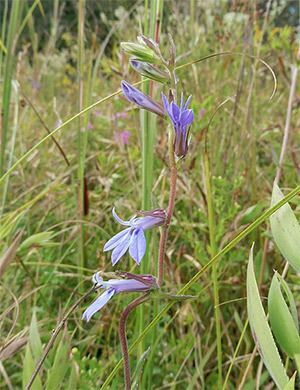Downy Lobelia

Lobelia puberula
Family: Campanulaceae (Bellflower Family)
Downy Lobelia (Lobelia puberula) is a beautiful native wildflower found in moist habitats throughout Southeast Texas. With its striking blue to violet flowers and upright growth habit, this perennial is a valuable addition to pollinator gardens, wetland restorations, and native plant landscapes. It thrives in partially shaded to sunny conditions and provides late-season nectar for bees, butterflies, and hummingbirds.
- Scientific Name: Lobelia puberula
- Common Names: Downy Lobelia
- Family: Campanulaceae (Bellflower Family)
- Growth Habit: Herbaceous perennial
- Height: 2-4 feet
- Leaves: Narrow, lance-shaped, with a slightly fuzzy texture
- Flowers: Blue to violet, tubular, with a two-lipped structure; blooms in tall, spike-like clusters
- Bloom Time: July – November in Southeast Texas
- Wildlife Benefits: Attracts bees, butterflies, and hummingbirds
Habitat & Range in Southeast Texas
Downy Lobelia thrives in moist, well-drained soils and is commonly found in:
- Wet Meadows & Stream Banks: Prefers areas with consistent moisture
- Pineywoods & Open Woodlands: Grows in light shade and dappled sunlight
- Prairie Edges & Roadside Ditches: Often seen along natural corridors with seasonal moisture
This adaptable species tolerates both wet and mesic soils and provides excellent seasonal color in naturalized plantings.
Ecological Importance
- Pollinator Plant: An important nectar source for bees, butterflies, and hummingbirds, especially in late summer and fall.
- Erosion Control: Helps stabilize soils in riparian zones and wetland edges.
- Wildlife Habitat: Supports native insects, which in turn benefit local bird populations.
Landscaping & Gardening Uses
Downy Lobelia is a fantastic addition to rain gardens, butterfly habitats, and naturalized landscapes.
Planting & Care
- Sunlight: Full sun to partial shade
- Soil: Prefers moist, well-drained sandy or loamy soils
- Water Needs: Moderate to high; thrives in damp conditions
- Maintenance: Minimal; cut back in winter to encourage new growth
- Companion Plants: Ideal alongside Swamp Milkweed (Asclepias incarnata), Cardinal Flower (Lobelia cardinalis), and Gulf Coast Penstemon (Penstemon tenuis)
Fun Facts
- The genus Lobelia is named after Matthias de l’Obel, a 16th-century Flemish botanist.
- Downy Lobelia is closely related to Cardinal Flower (Lobelia cardinalis) and shares similar pollinator-friendly traits.
- The plant’s late bloom period provides a critical nectar source when many other flowers have faded.
Conservation & Native Plant Advocacy
As native habitats continue to be impacted by development, planting species like Lobelia puberula helps support biodiversity and pollinator populations. Incorporating Downy Lobelia into Southeast Texas landscapes ensures a vibrant and ecologically beneficial garden.
Where to Find It
-
Interested in adding Downy Lobelia to your garden? Check if this is in stock or add to cart to purchase directly from our Natives Nursery.


